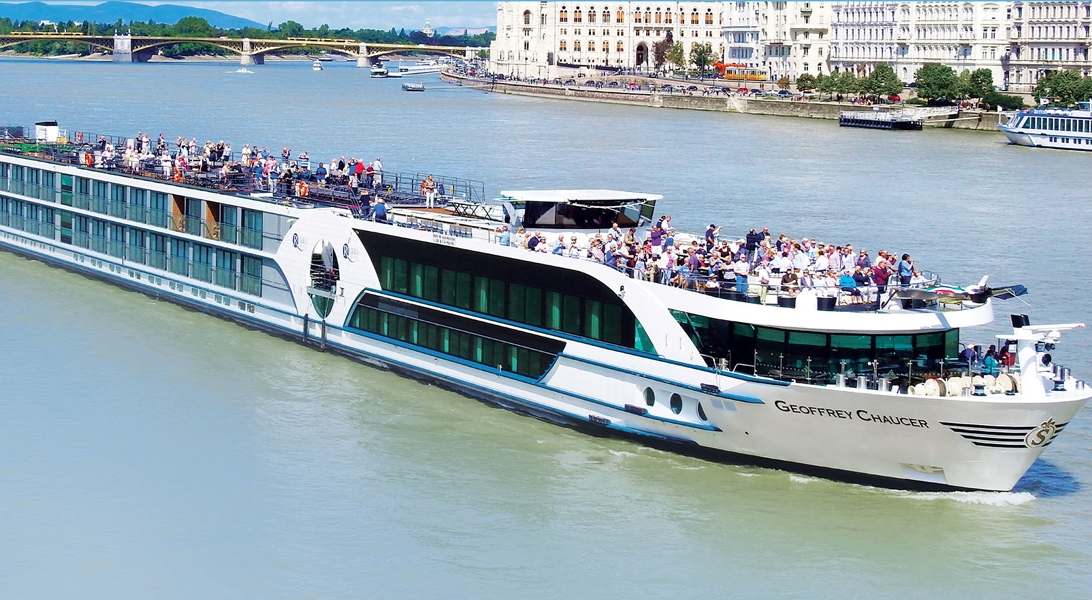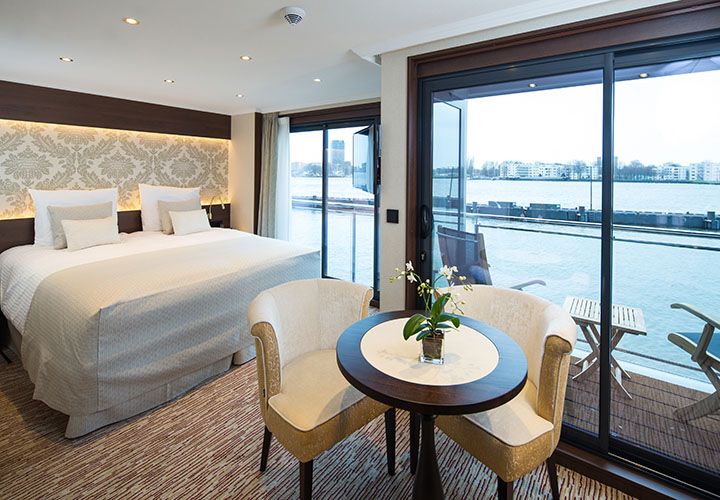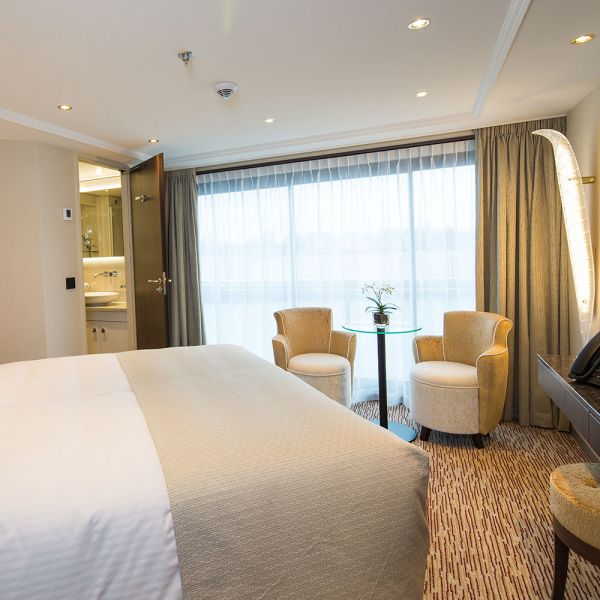This site uses cookies as defined in our Cookie Policy, by continuing to use this site you agree to their use.
Continue
| Arrive | Depart | ||||||
| 1st01 | AprApr | 202525 | Amsterdam, Netherlands, embark on the MS Geoffrey Chaucer | ||||
| Amsterdam combines the unrivaled beauty of the 17th-century Golden Age city center with plenty of museums and art of the highest order, not to mention a remarkably laid-back atmosphere. It all comes together to make this one of the world's most appealing and offbeat metropolises in the world. Built on a latticework of concentric canals like an aquatic rainbow, Amsterdam is known as the City of Canals—but it's no Venice, content to live on moonlight serenades and former glory. Quite the contrary: on nearly every street here you'll find old and new side by side—quiet corners where time seems to be holding its breath next to streets like neon-lit Kalverstraat, and Red Light ladies strutting by the city's oldest church. Indeed, Amsterdam has as many lovely facets as a 40-carat diamond polished by one of the city's gem cutters. It's certainly a metropolis, but a rather small and very accessible one. Locals tend to refer to it as a big village, albeit one that happens to pack the cultural wallop of a major world destination. There are scores of concerts every day, numerous museums, summertime festivals, and, of course, a legendary year-round party scene. It's pretty much impossible to resist Amsterdam's charms. With 7,000 registered monuments, most of which began as the residences and warehouses of humble merchants, set on 160 man-made canals, and traversed by 1,500 or so bridges, Amsterdam has the largest historical inner city in Europe. Its famous circle of waterways, the grachtengordel, was a 17th-century urban expansion plan for the rich and is a lasting testament to the city’s Golden Age. This town is endearing because of its kinder, gentler nature—but a reputation for championing sex, drugs, and rock ’n’ roll does not alone account for Amsterdam's being one of the most popular destinations in Europe: consider that within a single square mile the city harbors some of the greatest achievements in Western art, from Rembrandt to Van Gogh. Not to mention that this is one of Europe's great walking cities, with so many of its treasures in the untouted details: tiny alleyways barely visible on the map, hidden garden courtyards, shop windows, floating houseboats, hidden hofjes(courtyards with almshouses), sudden vistas of church spires, and gabled roofs that look like so many unframed paintings. And don’t forget that the joy lies in details: elaborate gables and witty gable stones denoting the trade of a previous owner. Keep in mind that those XXX symbols you see all over town are not a mark of the city's triple-X reputation. They're part of Amsterdam's official coat of arms—three St. Andrew's crosses, believed to represent the three dangers that have traditionally plagued the city: flood, fire, and pestilence. The coat's motto ("Valiant, determined, compassionate") was introduced in 1947 by Queen Wilhelmina in remembrance of the 1941 February Strike in Amsterdam—the first time in Europe that non-Jewish people protested against the persecution of Jews by the Nazi regime. Fly to Amsterdam from a choice of regional airports or take the Eurostar from London St Pancras International to Brussels, where you change trains and continue to Amsterdam. On arrival, transfer by coach to your five-star cruise ship moored near the city centre and railway station. The friendly crew welcomes you on board, helping you settle into your spacious and exquisitely furnished accommodation – you’ll feel immediately at home. | |||||||
| 2nd02 | AprApr | 202525 | Enkhuizen, Netherlands | ||||
| Overnight the ship has gently steered a course north. As dawn breaks, you’re greeted by views of Enkhuizen, a picturesque port nestling at the edge of the former Zuiderzee. It is also home to the Zuiderzee Museum, which we will experience on our visit this morning. Found in the historic centre of Enkhuizen, it superbly recreates the 19th-century heritage of Holland’s inland bay and combines interesting exhibits with demonstrations of the artisan skills of yesteryear, such as sailmaking, fish curing and blacksmithing. The open air museum is particularly captivating, as the era is brought to life with a charming village atmosphere, where the likes of bakers, shopkeepers and smokehouse workers don traditional clothing and serve you their wares, just as they would have done all those years ago. During the Dutch Golden Age of the 17th-century, the Netherlands dominated world maritime trade, becoming fabulously prosperous. Enkhuizen, as one of the country’s principal ports specialising in trade in the East Indies, flourished. Merchants keen to display their wealth created this town of gabled houses, narrow streets, bridges and waterways. It’s a delight to explore, taking in the atmosphere of its little streets and jumble of sailing boats in the harbour. After a delicious lunch on board, we cruise along the Markermeer, the southwestern part of the IJsselmeer, the great freshwater lake created when the Zuiderzee was separated from the North Sea by a series of dams and dykes built during the 1920 and ’30s. This mammoth engineering achievement now protects low-lying areas from flooding and has allowed the reclamation of 626 square miles of fertile land. Before long, thoughts turn to tonight’s à la carte dinner, served with panache by the restaurant staff, after which why not unwind with a digestif at the bar to the soothing sound of the ship’s pianist. | |||||||
| 3rd03 | AprApr | 202525 | Rotterdam, Netherlands | ||||
| Rotterdam is a city that's a long way removed from most people's stereotypical notion of the Netherlands. There are few, if any, canals to be found here nor are there any quaint windmills. There is, however, a thriving modern city which is one of the busiest ports in the entire world. Wake up in historic Rotterdam, the Netherlands’ second largest metropolis, situated where the Rhine flows into the North Sea. This morning we embark on a guided tour of this captivating city, from the old harbour to the modern architecture, passing by the Witte Huis, Europe’s first sky scraper, built in the Art Nouveau style. Known as the ‘Gateway to Europe’, it is the largest European cargo port and has been a conduit for trade since the 14th century. Unsurprisingly, its logistical significance made it a target for bombing during the Second World War and its old town was destroyed, with only the Church of Saint Lawrence left standing. During the following decades Rotterdam was reconstructed with typical Dutch optimism and engineering expertise and now boasts an abundance of innovative and imaginative architecture. Other highlights of Rotterdam include Europe’s largest swing bridge, the Erasmus Bridge, arched Markthal (market hall) and Cube Houses. The Erasmus Bridge is a cable-stayed and bascule construction in the heart of Rotterdam, which is aptly dubbed ‘the Swan’ because of its striking structure. Whilst the vibrant yellow Cube Houses, known locally as Kubuswoningen, are another architectural masterpiece. Built on stilts and tilted at bizarre angles, they were designed by Dutch architect Piet Blom in the 1970s and remain an iconic part of the city to this day. There are also excellent museums, such as the vast Boijmans Van Beuningen, which houses a world-class collection of works by old and modern masters, from Rembrandt to Van Gogh to Dalí, and some rare and beautiful glassware. During lunch on board you can enjoy a kaleidoscope of views through the restaurant’s panoramic windows as we leave Rotterdam’s skyline behind. A significant part of the Netherlands lies up to 22 feet below sea level, but an intricate network of dykes and polders, the Netherland’s unique drainage systems, has kept the seawater at bay and allowed land reclamation. At the very heart of this fascinating reclaimed region is Kinderdijk, our next port of call. Here, you can witness a truly iconic polder scene – a series of 19 authentic windmills lining the canal banks, set against a starkly beautiful backdrop of pancake-flat marshland. Windmills are symbolic of Dutch history and the never-ending battle with the sea, and visiting these beautifully preserved structures is like stepping back in time. Wrapping up a memorable day is the lavish Captain’s Dinner in the ship’s restaurant, as evening falls and the lights of this unforgettable city sparkle in the night. | |||||||
| 4th04 | AprApr | 202525 | Amsterdam, Netherlands | ||||
| Amsterdam combines the unrivaled beauty of the 17th-century Golden Age city center with plenty of museums and art of the highest order, not to mention a remarkably laid-back atmosphere. It all comes together to make this one of the world's most appealing and offbeat metropolises in the world. Built on a latticework of concentric canals like an aquatic rainbow, Amsterdam is known as the City of Canals—but it's no Venice, content to live on moonlight serenades and former glory. Quite the contrary: on nearly every street here you'll find old and new side by side—quiet corners where time seems to be holding its breath next to streets like neon-lit Kalverstraat, and Red Light ladies strutting by the city's oldest church. Indeed, Amsterdam has as many lovely facets as a 40-carat diamond polished by one of the city's gem cutters. It's certainly a metropolis, but a rather small and very accessible one. Locals tend to refer to it as a big village, albeit one that happens to pack the cultural wallop of a major world destination. There are scores of concerts every day, numerous museums, summertime festivals, and, of course, a legendary year-round party scene. It's pretty much impossible to resist Amsterdam's charms. With 7,000 registered monuments, most of which began as the residences and warehouses of humble merchants, set on 160 man-made canals, and traversed by 1,500 or so bridges, Amsterdam has the largest historical inner city in Europe. Its famous circle of waterways, the grachtengordel, was a 17th-century urban expansion plan for the rich and is a lasting testament to the city’s Golden Age. This town is endearing because of its kinder, gentler nature—but a reputation for championing sex, drugs, and rock ’n’ roll does not alone account for Amsterdam's being one of the most popular destinations in Europe: consider that within a single square mile the city harbors some of the greatest achievements in Western art, from Rembrandt to Van Gogh. Not to mention that this is one of Europe's great walking cities, with so many of its treasures in the untouted details: tiny alleyways barely visible on the map, hidden garden courtyards, shop windows, floating houseboats, hidden hofjes(courtyards with almshouses), sudden vistas of church spires, and gabled roofs that look like so many unframed paintings. And don’t forget that the joy lies in details: elaborate gables and witty gable stones denoting the trade of a previous owner. Keep in mind that those XXX symbols you see all over town are not a mark of the city's triple-X reputation. They're part of Amsterdam's official coat of arms—three St. Andrew's crosses, believed to represent the three dangers that have traditionally plagued the city: flood, fire, and pestilence. The coat's motto ("Valiant, determined, compassionate") was introduced in 1947 by Queen Wilhelmina in remembrance of the 1941 February Strike in Amsterdam—the first time in Europe that non-Jewish people protested against the persecution of Jews by the Nazi regime. A long spring season and the polders’ well-drained soil create the perfect environment for growing the Netherlands’ world-famous tulips, first imported into the country from the Ottoman Empire in the late 16th century. This morning we drive through the scenic bulb fields to Keukenhof, the world’s largest flower garden, covering nearly 80 acres. Nothing prepares you for the dazzling carpet of colours created by the seven million tulips, hyacinths, daffodils and other blooms arranged in rows, swirls and every other imaginable shape. The art of flower planting reaches breathtaking heights in Keukenhof’s themed areas, and wandering among this dramatic pageant of hues set in a landscape of lakes, trees, pavilions and water features is magical – and provides gardeners with a wealth of inspiration to take home! We return to Amsterdam to explore this beautiful city on a classic glass-topped canal cruiser. A network of 165 canals built in rings during the 17th century defines life in its centre, and our ‘water’s-eye view’ is the best way to absorb Amsterdam’s history. Relax and watch this unique cityscape unfold as our guide explains the many intriguing aspects of life here. You’ll see moored houseboats, quirky bridges, cobbled streets lined with tall, narrow merchants’ houses, gabled civic buildings and homes of famous former residents such as Rembrandt, the greatest Dutch Golden Age artist, and Anne Frank, whose diaries tell a poignant tale of life under the Nazis. Amsterdam is the ideal walking city and we remain moored dockside so you can explore its characterful streets at your leisure. Exceptional art is always close by, from small galleries to the world-class Rijksmuseum and the Van Gogh Museum, both holding huge collections. You might choose to discover the interior of Anne Frank’s house, rummage through the Waterlooplein flea market or relax at a café sipping a rich Dutch coffee and watching the locals trundle over cobbles along the canals on their high-handlebar bicycles. Later we return to the cruise ship, where the chef has prepared a sumptuous dinner. | |||||||
| 5th05 | AprApr | 202525 | Amsterdam, Netherlands, disembark the MS Geoffrey Chaucer | ||||
| Amsterdam combines the unrivaled beauty of the 17th-century Golden Age city center with plenty of museums and art of the highest order, not to mention a remarkably laid-back atmosphere. It all comes together to make this one of the world's most appealing and offbeat metropolises in the world. Built on a latticework of concentric canals like an aquatic rainbow, Amsterdam is known as the City of Canals—but it's no Venice, content to live on moonlight serenades and former glory. Quite the contrary: on nearly every street here you'll find old and new side by side—quiet corners where time seems to be holding its breath next to streets like neon-lit Kalverstraat, and Red Light ladies strutting by the city's oldest church. Indeed, Amsterdam has as many lovely facets as a 40-carat diamond polished by one of the city's gem cutters. It's certainly a metropolis, but a rather small and very accessible one. Locals tend to refer to it as a big village, albeit one that happens to pack the cultural wallop of a major world destination. There are scores of concerts every day, numerous museums, summertime festivals, and, of course, a legendary year-round party scene. It's pretty much impossible to resist Amsterdam's charms. With 7,000 registered monuments, most of which began as the residences and warehouses of humble merchants, set on 160 man-made canals, and traversed by 1,500 or so bridges, Amsterdam has the largest historical inner city in Europe. Its famous circle of waterways, the grachtengordel, was a 17th-century urban expansion plan for the rich and is a lasting testament to the city’s Golden Age. This town is endearing because of its kinder, gentler nature—but a reputation for championing sex, drugs, and rock ’n’ roll does not alone account for Amsterdam's being one of the most popular destinations in Europe: consider that within a single square mile the city harbors some of the greatest achievements in Western art, from Rembrandt to Van Gogh. Not to mention that this is one of Europe's great walking cities, with so many of its treasures in the untouted details: tiny alleyways barely visible on the map, hidden garden courtyards, shop windows, floating houseboats, hidden hofjes(courtyards with almshouses), sudden vistas of church spires, and gabled roofs that look like so many unframed paintings. And don’t forget that the joy lies in details: elaborate gables and witty gable stones denoting the trade of a previous owner. Keep in mind that those XXX symbols you see all over town are not a mark of the city's triple-X reputation. They're part of Amsterdam's official coat of arms—three St. Andrew's crosses, believed to represent the three dangers that have traditionally plagued the city: flood, fire, and pestilence. The coat's motto ("Valiant, determined, compassionate") was introduced in 1947 by Queen Wilhelmina in remembrance of the 1941 February Strike in Amsterdam—the first time in Europe that non-Jewish people protested against the persecution of Jews by the Nazi regime. This morning, we transfer to the railway station or airport for our return journey. | |||||||

The images shown are for illustration purposes only and may not be an exact representation of what you find on the ship.

If you’re looking to really spoil yourself, at a staggering 25 square metres (269 square feet), the world-class Diamond (upper) Deck Deluxe Balcony Suites are for you. Fifty percent larger than standard suites, they allow for an even more generous living area for the ultimate in space and comfort. In addition you will enjoy a private exterior balcony complete with table and chairs - perfect for an ‘al fresco’ breakfast should you wish or just a quiet morning coffee or a pre-dinner ‘sundowner’ whilst watching the world drift by. With the same fittings as standard suites, exquisitely and lavishly appointed to the very highest standard, plus complimentary soft cotton bathrobes and slippers adding the final little touch, this really is the epitome of river cruise luxury!
Indulge in the luxury of Riviera Plus when you stay in an upper deck cabin or suite. In your well-appointed cabin, you’ll find a range of extras to make your experience extra special.

Bringing your cruise to another level, why not upgrade to a Superior Suite available on the Ruby (middle) and Diamond (upper) decks. Substantially larger at 23 square metres (247 sq. feet) and with the additional space devoted to the living area, you will immediately notice the benefit as you relax in your stylish surroundings. Of course the identical high quality furnishings and fittings as the standard suite are evident throughout, again with stunning views from the panoramic floor to ceiling sliding glass doors.
Indulge in the luxury of Riviera Plus when you stay in an upper deck cabin or suite. In your well-appointed cabin, you’ll find a range of extras to make your experience extra special.
The images shown are for illustration purposes only and may not be an exact representation of what you find on the ship.
The images shown are for illustration purposes only and may not be an exact representation of what you find on the ship.
The images shown are for illustration purposes only and may not be an exact representation of what you find on the ship.
The images shown are for illustration purposes only and may not be an exact representation of what you find on the ship.
| Return flights including luggage allowance | |||
| Overseas Transfers | |||
| 4 nights cruising on the Dutch Waterways | |||
| Fascinating daily tours & excursions with expert guides | |||
| Exceptional dining from breakfast to midnight snacks | |||
| Complimentary Wi-Fi | |||
| Complimentary tea, coffee on-board | |||
| Return overseas airport transfers | |||
| Port Taxes and Fees | |||
 | ABTA and ATOL Protection* | ||
Date 1st Apr 2025 |
Nts 4 |
Please Call for Availability |
Date 1st Apr 2025 |
Nts 4 |
Please Call for Availability |
Fusion Cruises when selling travel arrangements is a trading name of The Midcounties Co-operative Ltd. Fusion Cruises is an Accredited Body Member of Midcounties Co-operative Travel Consortium. (ABTA:P6652, ATOL:6053).
Book with Confidence. We are a Member of ABTA which means you have the benefit of ABTA’s assistance and Code of Conduct.
Some of the flights and flight-inclusive holidays on this website are financially protected by the ATOL scheme but ATOL protection does not apply to all holiday and travel services offered on this website. This website will provide you with information on the protection that applies in the case of each holiday and travel service offered before you make your booking. If you do not receive an ATOL Certificate then the booking will not be ATOL protected. If you do receive an ATOL Certificate but all parts of your trip are not listed on it, those parts will not be ATOL protected. Please see our booking conditions for information, or for more information about financial protection and the ATOL Certificate go to: www.caa.co.uk
